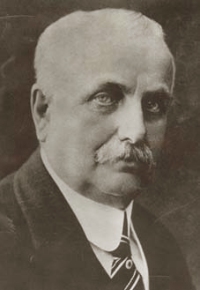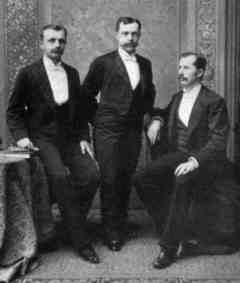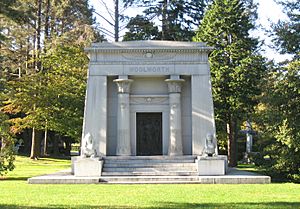Frank Winfield Woolworth facts for kids
Quick facts for kids
Frank Winfield Woolworth
|
|
|---|---|
 |
|
| Born | April 13, 1852 Rodman, New York, US
|
| Died | April 8, 1919 (aged 66) |
| Resting place | Woodlawn Cemetery |
| Education | Watertown Commercial College |
| Known for | Founded F. W. Woolworth Company (now Foot Locker) |
| Political party | Republican |
| Spouse(s) |
Jennie Creighton
(m. 1876) |
| Children | 3 |
| Relatives | Charles S. Woolworth (brother) Barbara Hutton (granddaughter) Seymour H. Knox I (cousin) |
| Signature | |
Frank Winfield Woolworth (born April 13, 1852 – died April 8, 1919) was an American businessman. He started the F. W. Woolworth Company, a chain of stores known as "Five-and-Dimes." These stores sold many different items at very low prices.
Frank Woolworth changed how stores worked. He was one of the first to buy products directly from the people who made them. He also set fixed prices on items, so customers didn't have to bargain. He even introduced self-service displays, letting shoppers pick up and look at items themselves. This was a new idea at the time!
Contents
Early Life
Frank Woolworth was born in Rodman, New York. His parents were John and Fanny Woolworth. He had a brother named Charles Sumner Woolworth, who also became a businessman. Their family was very religious and supported the Northern side during the American Civil War.
When Frank was just four years old, he told his parents he wanted to be a peddler, someone who sells things door-to-door. He and Charles would often play "store" together. Frank would set up items to sell to his brother. He finished school at 16 but found it hard to get a job in a store because he had little experience. He borrowed money from his mother to attend a business college in Watertown, New York.
His Business Journey
In 1873, Frank Woolworth got a job at a general store called Augsbury & Moore's Drygoods in Watertown. This job taught him a lot about how stores operated. At first, he wasn't very good at selling. So, his boss gave him tasks like washing windows. Frank became very good at arranging the store's front displays, making them look appealing.
Back then, most items in stores didn't have price tags. A clerk had to get each item for the customer and tell them the price. Frank realized this made shopping slow and difficult. He thought that products should "sell themselves" if they were displayed well and had clear prices. This idea became very important in his career.
Frank had a chance to open a small store in Great Bend in 1878 to sell extra goods. But it didn't do well and closed after a few months. The idea for the "five-and-dime" store came from different stories. Some say he heard about other stores selling items for five cents. Others say a traveling salesman told him about the idea.
Frank borrowed $300 and opened his first five-cent store in Utica, New York, on February 22, 1879. Sadly, it closed within weeks. But he didn't give up! He opened his second store in April 1879 in Lancaster, Pennsylvania. Here, he added items that cost ten cents, expanding his idea.

By 1889, Frank Woolworth had 12 successful stores. In just ten years, his sales grew by a huge amount. By 1900, his chain had 59 stores, selling over $5 million worth of goods. He even started buying smaller chains of competing stores. This helped his company become a leader in selling low-priced items in America.
In 1911, the F. W. Woolworth Company officially became a big corporation with 586 stores. In 1913, Woolworth built the famous Woolworth Building in New York City. It cost $13.5 million in cash! At 792 feet tall, it was the tallest building in the world at that time.
Frank Woolworth sometimes visited his stores without telling anyone. He would sometimes pretend to take items to see if the staff were paying attention. Managers or clerks who noticed him and spoke up were sometimes rewarded with promotions.
Personal Life
Frank Woolworth married Jennie Creighton in 1876. They had three daughters: Helena, Jessie, and Edna. Sadly, Edna died young. She was the mother of Barbara Hutton, who later became a famous socialite.
Death
Frank Woolworth passed away on April 8, 1919, just before his 67th birthday. At the time of his death, he was very wealthy. His company owned over 1,000 stores in the United States and other countries. It was a huge business worth millions of dollars. He died without signing his newest will, so his wife inherited everything according to an older will.
Frank Woolworth is buried in the Woodlawn Cemetery in the Bronx, New York City.
Legacy
- There are bronze statues honoring Woolworth and other important business leaders in downtown Chicago, Illinois.
- Woolworth was added to the Junior Achievement Business Hall of Fame in 1995.
- A cemetery near Watertown, New York, where he started his first store, is named after him.
The Woolworth Company Today
After Frank Woolworth's death, the company changed over time. In the 1960s, it started opening different types of specialty stores. One of these was a sportswear store, which later became Foot Locker. In 1974, the first Foot Locker sporting goods store opened. For a while, there was also a chain of discount stores called Woolco.
By 1997, the original Woolworth chain had only 400 stores left. Other parts of the company, like Foot Locker, were making more money. So, on July 17, 1997, the original Woolworth stores closed. The company changed its name to Venator, and then in 2001, it became Foot Locker, Inc.. In 2012, Foot Locker celebrated Woolworth's 100th anniversary on the New York Stock Exchange.
Woolworth stores in the United Kingdom (UK) were owned separately after 1982. They continued to operate under the Woolworth name until January 6, 2009, when the last UK stores closed. The UK Woolworths brand was later bought and operated online for a few years. Woolworth stores still operate in Germany today.
It's interesting to know that the Australian and South African companies also took their names from Woolworth's stores. However, they are not connected to Frank W. Woolworth's original company.
See also
 In Spanish: Franklin Winfield Woolworth para niños
In Spanish: Franklin Winfield Woolworth para niños
- List of Woolworth buildings
- Mr Selfridge (Episode 8)



